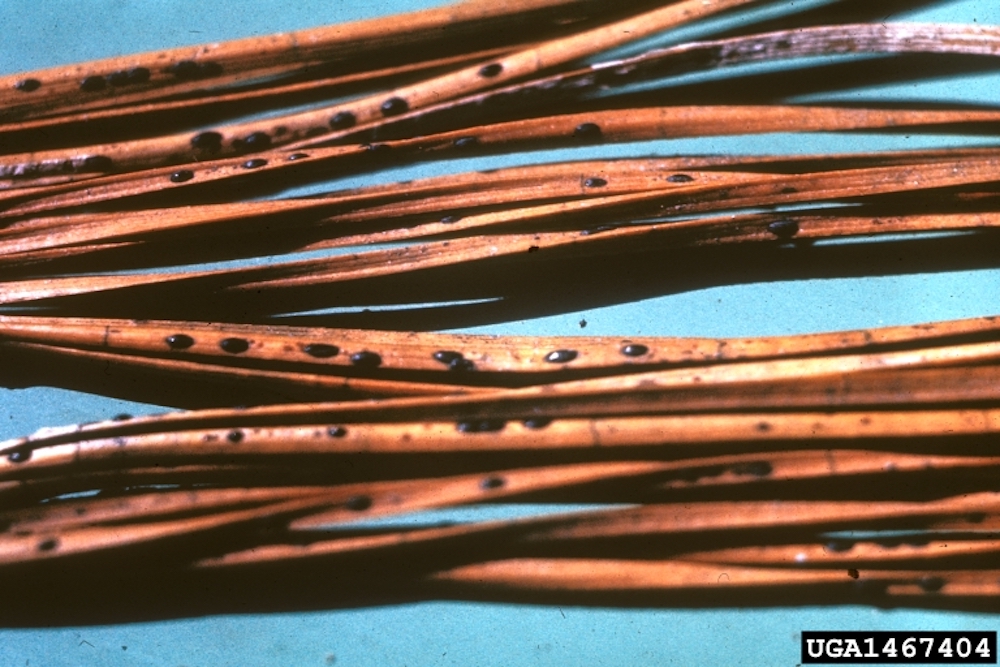needlecast








Even though they're called evergreens, trees such as pine, Douglas fir, and spruce naturally lose some of their needled leaves each year. However, severe loss of needles often signals diseases such as needlecast at work.
Needlecast diseases caused by fungal pathogens such Lophodermium, Rhabdocline, and Rhizosphaera cause these conifers to cast off large amounts of needles prematurely. Only the newest, current year's growth stays green, as needles on branches become sparse and thin. Wind and water spread needlecast-spawning fungi. Crowded, wet conditions promote these diseases.
Needlecast Identification/Symptoms: Needlecast symptoms vary depending on the type of tree and the specific fungi involved. New growth becomes infected during the regular growing season, but symptoms don't show until late winter and early spring. Infected needles typically develop yellow or brown spots, and spring may also bring shades of purple or red.
Close examination of infected, dropped needles may show rows of shiny, raised, black fungal spots. The innermost needles on the lowest branches are often affected most, as spores from fallen needles left on the ground re-infect branches above.
How to Control Needlecast: Because needlecast infections happen long before symptoms appear, effective control calls for proactive, preventive treatments. Daconil® Fungicide Concentrate from GardenTech® brand offers highly effective protection against diseases such as Lophodermium needlecast in pine, Douglas fir, and spruce; Rhabdocline and Swiss needlecast in Douglas fir; and Rhizosphaera needlecast in spruce.
Used with a hand-held, hose-end, or tank-style sprayer, Daconil® Fungicide Concentrate treats these needled evergreens easily and economically. Measure the recommended concentrate amount with the convenient measuring cap. Pour it into your sprayer, add the recommended amount of water, and mix well. Spray to cover all needle and branch surfaces until thoroughly wet.
Begin needlecast treatments in spring when new needles are 1/2-2 inches long. In the Northeast and Northcentral states, start spraying for Lophodermium needlecast in mid-July and early August. Once treatments begin, reapply Daconil® fungicide every three to four weeks until dry weather stabilizes.
Needlecast Tips: Space evergreens to allow for good air circulation, so needles dry well. Remove heavily infested trees, and prune out infected branches. Always rake and dispose of needles that fall to the ground. You'll help prevent reinfections from cast leaves.
Always read product labels thoroughly and follow instructions, including guidelines for treatable plants, application rates, and frequencies.
GardenTech is a registered trademark of Gulfstream Home and Garden, Inc.
Daconil is a registered trademark of GB Biosciences Corp.
Photo Credit:
USDA Forest Service, Northern and Intermountain Region, USDA Forest Service, Bugwood.org (CC BY 3.0 US)
USDA Forest Service - Ogden, USDA Forest Service, Bugwood.org (CC BY 3.0 US)
Joseph O'Brien, USDA Forest Service, Bugwood.org (CC BY 3.0 US)
Joseph O'Brien, USDA Forest Service, Bugwood.org (CC BY 3.0 US)
Photo credit: USDA Forest Service, USDA Forest Service, Bugwood.org (CC BY 3.0 US)
Terry S. Price, Georgia Forestry Commission, Bugwood.org (CC BY 3.0 US)
Frantisek Soukup, Bugwood.org (CC BY 3.0 US)


